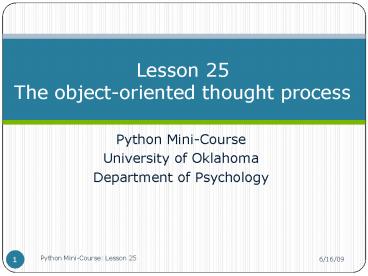Python Mini-Course - PowerPoint PPT Presentation
Title:
Python Mini-Course
Description:
A program that uses O-O is basically a collection of objects ... OOP example: animals.py. class Animal: def __init__(self, name): # Constructor of the class ... – PowerPoint PPT presentation
Number of Views:67
Avg rating:3.0/5.0
Title: Python Mini-Course
1
Lesson 25The object-oriented thought process
- Python Mini-Course
- University of Oklahoma
- Department of Psychology
2
Lesson objectives
- Define the key terms used in object-oriented
programming (OOP) - Understand the difference between an object and a
class - Describe the types of relationships that are
possible between objects
3
Procedural vs. OOP
- Review from Lesson 6
- Procedural programming separates the program
operations and the data - Object-oriented programming packages the program
operations and the data together in object
4
What is an object?
- The building blocks of an O-O program
- A program that uses O-O is basically a collection
of objects - Objects interact much like things in the real
world do
5
What is an object?
- Objects have two components
- Data (i.e., attributes)
- Behaviors (i.e., methods)
6
Object attributes
- Store the data for that object
- Example (taxi)
- Driver
- OnDuty
- NumPassengers
- Location
7
Object methods
- Define the behaviors for the object
- Example (taxi)
- PickUp
- DropOff
- GoOnDuty
- GoOffDuty
- GetDriver
- SetDriver
- GetNumPassengers
8
Object interface
- To use a method, the user (programmer) must know
- Name of the method
- Parameters to pass to the method
- What (if anything) the method returns
9
Object implementation
- The user does NOT need to know how the method
works internally
10
What is a Class?
- A blueprint for an object
- Classes can be thought of as templates or cookie
cutters - Given a class description, we can instantiate
objects of that class - Classes are high-level data types
11
OOP concepts
- Encapsulation
- Data and behaviors are packaged together, but the
object only reveals the interfaces needed to
interact with it - Internal data and behaviors can remain hidden
12
OOP concepts
- Interfaces
- Fundamental means of communication between
objects - Should completely describe to user (programmer)
how to interact with the object - Should control access to attributes
13
Inheritance
- You can create new classes by abstracting out
common attributes and behaviors from a parent (or
base) class
14
(No Transcript)
15
Is-a relationship
- Because sub-classes inherit from their base
class, they have an is-a relationship - Lion is a cat
- Cat is a mammal
16
Polymorphism
- Allows similar objects to to respond to the same
message (method call) in different manners - Sub-classes can override base class methods
17
OOP example animals.py
- class Animal
- def __init__(self, name) Constructor of
the class - self.name name
- class Cat(Animal)
- def talk(self)
- return 'Meow!'
- class Dog(Animal)
- def talk(self)
- return 'Woof! Woof!'
18
Composition
- Objects can contain other objects
- This is called a has-a relationship
- Example
- Taxi has-a driver

